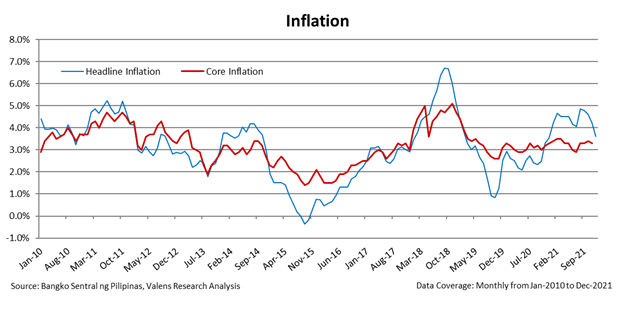MONDAY MACRO: Pork prices remain a concern for Philippine inflation

Along with the surge of COVID-19 cases since 2020, the Philippine inflation rate also increased due to a disruption of the supply chain. Although the country’s inflation rate has been declining, pork inflation remains a point of concern.
Today, we’ll take a look at how pork prices affected consumers and how the government is addressing this concern.
Philippine Markets Newsletter:
The Monday Macro Report
Powered by Valens Research
As we have discussed in our previous newsletters, inflation has been one of the Philippine economy’s biggest concerns since early 2021. This is partially because of the global supply chain constraints that are causing supply-demand imbalances.
In the Philippines, food and non-alcoholic beverage commodities are the highest contributors to high inflation. Since the start of the pandemic, the shortage in supply for most food products led to more expensive prices.
Among the top drivers of inflation is meat prices. Aside from supply shortage, another factor that caused these high prices is the African Swine Fever (ASF) outbreak in the Philippines.
That said, this December, the Philippines recorded a 3.6% inflation rate, an expected decline from 4.2% in November since it is within the 2%-4% guidance provided by the Bangko Sentral ng Pilipinas (BSP).

The current decline in inflation is thanks to slower food inflation, which fell from 4.1% in November 2021 to 3.2% in December 2021. Particularly, vegetable inflation also declined from -1.8% to -10% and fish inflation also slowed from 7.9% to just 7%.
However, meat inflation was up to 11.3% this December, from 10.7% in the previous month, partly due to the increase in pork prices.
In its attempt to ease the ongoing concerns on pork inflation, the government temporarily lowered tariff rates last year for pork imports. However, prices remained elevated.
There are two main reasons why pork prices had remained high in mid-2021: meat processors were not allowed to import pork and the sale of imported meat was not allowed at room temperature.
Given that local food processors were prohibited from using imported pork, the prices of canned and processed pork in the market remain high.
Moreover, with the temperature requirement, the imported meat products are inaccessible to most Filipinos who buy their meats at public wet markets that do not have any refrigerators. Imported meat products can be purchased mostly in supermarkets, which maintained—and did not roll back—their prices since public markets have no power to offer competition.
To resolve the first issue, the Department of Agriculture (DA) issued a memorandum to allow food processors to use imported meats in their production. That should somewhat ease supply constraints for the industry.
The DA also ordered the distribution of imported meat to areas outside Metro Manila, wet markets, and institutional buyers.
Additionally, the Department of Finance (DOF) and National Economic and Development Authority (NEDA) are pushing for the extension of the lower tariff executive order until December 2022 to help stabilize pork prices at a lower level.
While the lower tariffs should increase pork supply in the Philippines, global pork prices remain elevated. As such, we expect inflation to remain at current levels, if not improve slightly.
About the Philippine Markets Newsletter
“The Monday Macro Report”
When just about anyone can post just about anything online, it gets increasingly difficult for an individual investor to sift through the plethora of information available.
Investors need a tool that will help them cut through any biased or misleading information and dive straight into reliable and useful data.
Every Monday, we publish an interesting chart on the Philippine economy and stock market. We highlight data that investors would normally look at, but through the lens of Uniform Accounting, a powerful tool that gets investors closer to understanding the economic reality of firms.
Understanding what kind of market we are in, what leading indicators we should be looking at, and what market expectations are, will make investing a less monumental task than finding a needle in a haystack.
Hope you’ve found this week’s macro chart interesting and insightful.
Stay tuned for next week’s Monday Macro report!
Regards,
Angelica Lim
Research Director
Philippine Markets Newsletter
Powered by Valens Research
www.valens-research.com




